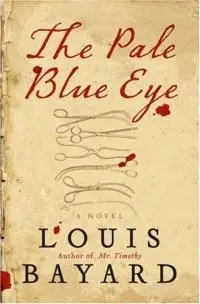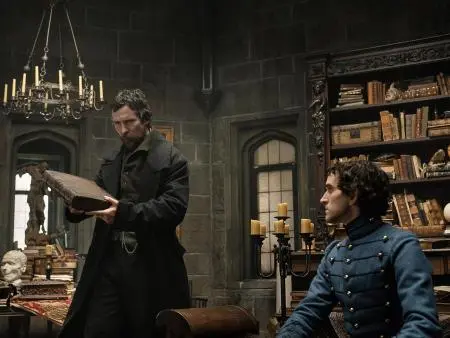Edgar Allan Poe is widely considered the inventor of detective fiction, and his death is something of an enigma (was it the result of his alcoholism, or something more sinister?), so it seems fitting that the author should be the subject of a fictional murder mystery narrative involving a kind of hardboiled detective transplanted to the 1830s. Such is the basic premise of Louis Bayard’s 2003 novel, The Pale Blue Eye, adapted for the screen by Scott Cooper (Antlers, Crazy Heart) and released twenty years later (or nineteen, if you count the film’s limited theatrical run in December 2022).
Book and movie are virtually identical here, minus a few surface changes made for the sake of narrative economy. In weighing the story’s journey from page to screen, then, three questions must be answered:
- Is one particular problematic aspect of the novel addressed/fixed in the film?
- Is the narrative still magnetic the second time around, once the mystery has been solved and all secrets have been revealed?
Before diving right in, the obligatory SPOILER warning must be inserted here. Don’t read on if you’d rather not know what happens.
The Book
 While Poe certainly plays an integral role in the narrative, he is only a secondary character. The protagonist and main detective is Gus Landor, a retired New York constable who is recruited by bigwigs at the West Point military academy — two more fictionalized historical figures, Colonel Sylvannus Thayer and Captain Ethan Allen Hitchcock — to investigate an apparent suicide and subsequent corpse desecration of a young cadet named Leroy Fry. It seems after hanging himself in the woods outside the academy grounds, someone removed Fry’s heart, and Thayer and Hitchcock employ Landor to find the person or persons responsible, hoping for the sake of decorum the culprits aren’t other cadets or West Point personnel. Landor in turn elicits the help of an older student at the academy, fourth classman Edgar Allan Poe, to act as his inside man (read: spy on his fellow cadets and report any pertinent information).
While Poe certainly plays an integral role in the narrative, he is only a secondary character. The protagonist and main detective is Gus Landor, a retired New York constable who is recruited by bigwigs at the West Point military academy — two more fictionalized historical figures, Colonel Sylvannus Thayer and Captain Ethan Allen Hitchcock — to investigate an apparent suicide and subsequent corpse desecration of a young cadet named Leroy Fry. It seems after hanging himself in the woods outside the academy grounds, someone removed Fry’s heart, and Thayer and Hitchcock employ Landor to find the person or persons responsible, hoping for the sake of decorum the culprits aren’t other cadets or West Point personnel. Landor in turn elicits the help of an older student at the academy, fourth classman Edgar Allan Poe, to act as his inside man (read: spy on his fellow cadets and report any pertinent information).
In the course of their joint investigation, another student, Randy Balenger, is killed in an identical fashion as Fry (with the addition of a castration), while a third, Cadet Stoddard, goes missing. Landor and Poe eventually discover West Point’s resident physician Dr. Daniel Marquis’s family are practicing occultists who aim to grant daughter Lea Marquis eternal life to escape her “falling sickness” (an archaic term for epilepsy), which matriarch Julia blames for Lea’s inability to land a husband. Along with son Artemis, the family kidnaps Poe, drains some of his blood, and uses it in a ritual that also involves Lea eating Fry’s extracted heart. Landor, however, interrupts the proceedings, saves Poe’s life, and restores order to West Point. Mystery solved.
Except, Poe comes to visit Landor at his cabin not long after and reveals that he has deduced the “good constable’s” ultimate secret. It seems that around a year prior, three West Point cadets assaulted Landor’s daughter Mattie, leading her to take her own life. Gus was able to determine, through his affair with local barmaid Patsy, that one of the offending boys was Fry, revealing the cadet was indeed murdered, but not by Artemis, Lea, and Julia, but Landor himself (they merely extracted the heart for the ritual, but swore they would never take a life in their pursuit of Lea’s immortality). Landor also murdered Balenger, the second offender, and made it look appropriately occult-like in nature so that he could sufficiently blame the crimes on the Marquises. Stoddard, the third boy on Landor’s kill list, saw the writing on the wall and escaped.
Poe spurns Landor for his crimes, but resolves not to turn him in, prompting the old detective to hurl himself off a cliff, the same manner in which his own daughter met her end. Mystery solved, for real this time.
All in all, Bayard’s narrative is an effective mystery with a solid twist echoing the William Hjortsberg novel/Alan Parker film Angel Heart, though one that peppers in a little Death Wish as well and, as a result, sadly hinges upon the tired trope of “fridging” a female character to motivate a male character’s actions.
The Film
Before answering the two questions above, it’s worth mentioning that the entire cast does a fantastic job with the material, even if some of them have considerably less than others — primarily, Charlotte Gainsbourg as Patsy and Gillian Anderson as Julia, two excellent performers whose talents feel just a tad wasted here. Christian Bale’s ability to play both grizzled and tortured at the same time made him a fine choice for Landor, but the real star of the show is Harry Melling as Poe, who brings the characters moon-howling romanticism, sometimes insufferable intellect, and burgeoning proto-Gothness to captivating life. The cinematography by Masanobu Takayanagi is magnificent and Howard Shore’s score is just reminiscent enough of his work on The Silence of the Lambs to conjure a similar sense of sweeping, macabre tragedy without being redundant.
Unfortunately, because this is such a faithful adaptation, the fridging is left intact. It’s a somewhat more forgivable element of Bayard’s work, given that the novel came out in 2003, a time when, culturally speaking, we didn’t talk as much about these types of tropes, but for a 2022/2023 film, the plot point sticks out like a sore thumb. So, in the case of question number one, the answer is “no.”
But on top of that, Cooper and company skip on their one chance to cast a non-white actor. Bayard’s novel featured a half-Indigenous eccentric professor named Pawpaw who helps Poe and Landor learn all they need to know about the occult, but in the film, he’s a Frenchman named Pepe and he’s played by veteran actor Robert Duvall. As Pawpaw’s tribe is never revealed, any number of elder Indigenous actors could have played the role — Wes Studi, Gary Farmer, or Graham Greene perhaps, to name just three. It’s an odd choice on behalf of the filmmakers to be sure, especially since this slim bit of inclusivity was already baked into the source material.
As for the final question, whether or not the narrative is still enjoyable once all its secrets have been revealed: mostly it’s a yes. It’s fun to see Bale’s subtle reactions to incriminating evidence, and his ability to play it off with an almost insidious casualness. Since anyone who read the novel already knows that Landor is in fact secretly searching out the boys who harmed his daughter and finding his scapegoats while simultaneously investigating the surface mystery, it’s interesting watching these scenarios play out in real time. So the second time experiencing the narrative isn’t drudgery, but it’s hard to consider revisiting The Pale Blue Eye any more than this, either on page or on screen.
Get The Pale Blue Eye at Bookshop or Amazon

About the author
Christopher Shultz writes plays and fiction. His works have appeared at The Inkwell Theatre's Playwrights' Night, and in Pseudopod, Unnerving Magazine, Apex Magazine, freeze frame flash fiction and Grievous Angel, among other places. He has also contributed columns on books and film at LitReactor, The Cinematropolis, and Tor.com. Christopher currently lives in Oklahoma City. More info at christophershultz.com








